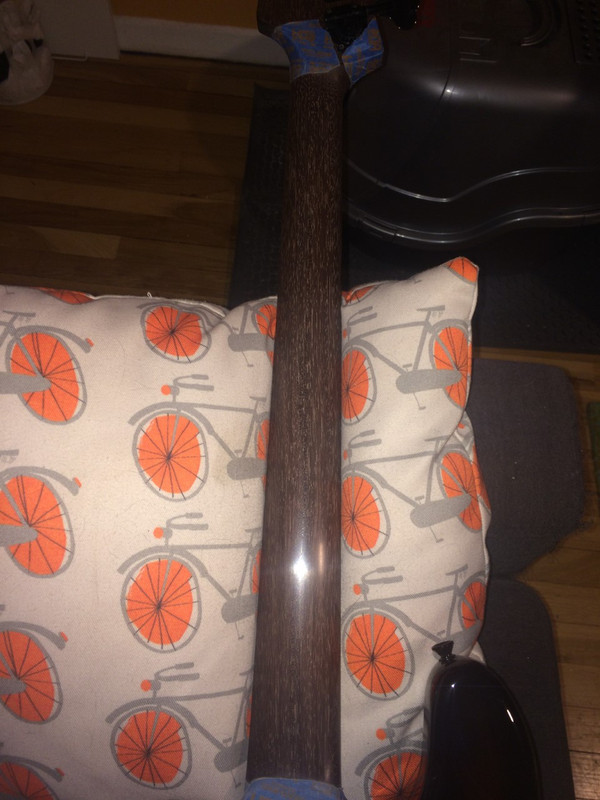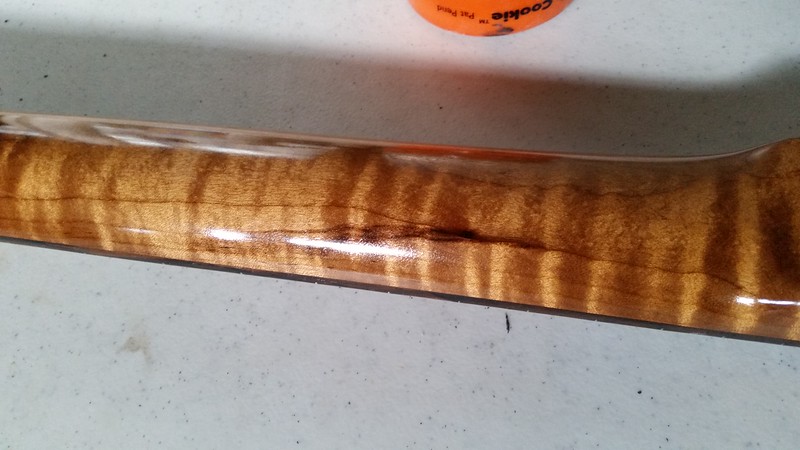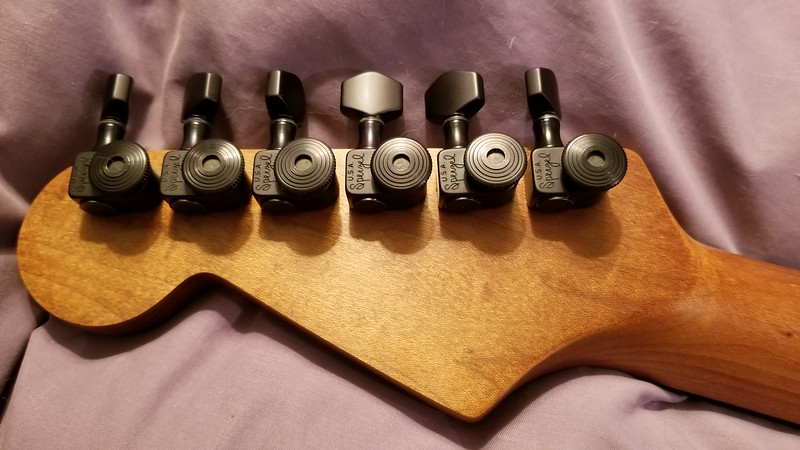
You are using an out of date browser. It may not display this or other websites correctly.
You should upgrade or use an alternative browser.
You should upgrade or use an alternative browser.
Burnishing Raw Necks
- Thread starter Cagey
- Start date
Cagey
Mythical Status
- Messages
- 24,425
I'm fortunate enough that I don't have to clean very often, but when I do, I just use naphtha. It cuts gunk pretty well without parching the wood the way a more aggressive solvent like acetone, xylene or MEK would. I've also found that a burnished 'board doesn't get gunky like some do, due to its smoother finish that doesn't abrade skin cells off as quickly. Also, your fingers will provide far more oil than the wood ever needs, which is part of the reason the 'board needs cleaning in the first place, so don't add any oil to it and force a need to clean too often.
GT1-Reach
Junior Member
- Messages
- 49
Hey guys,
So I've burnished my first neck (a cheap Squier but I like it) and I have to say it's nice. This is a very, very slick feeling.
But
For my personal taste, nothing beats the feeling of a road worn I once owned.
Anybody got tips to achieve a neck feeling like on a road worn? Mine was a 50s road worn made in 2015.
I can't really descripe the feeling, it was pretty raw feeling, kind of rough and coarse but still slick feeling. It's hard to describe.
I maybe habe pictures of its neck and I will post them eventually.
So I've burnished my first neck (a cheap Squier but I like it) and I have to say it's nice. This is a very, very slick feeling.
But
For my personal taste, nothing beats the feeling of a road worn I once owned.
Anybody got tips to achieve a neck feeling like on a road worn? Mine was a 50s road worn made in 2015.
I can't really descripe the feeling, it was pretty raw feeling, kind of rough and coarse but still slick feeling. It's hard to describe.
I maybe habe pictures of its neck and I will post them eventually.
Cagey
Mythical Status
- Messages
- 24,425
I haven't had to, and haven't heard of anyone else having to (and it's getting to be a popular procedure), but I know in my case I'm not putting in the playing time I used to. I tend to think it wouldn't need to be reworked. Given time, hands alone are abrasive enough on their own to accomplish the same thing. It just takes years instead of hours.
Cagey
Mythical Status
- Messages
- 24,425
I did it (lengthwise) by hand for a long time, but then I tried a 4" D/A on one in the interest of saving time/effort, which worked out well. Cuts the time in about 1/2. Same progression of papers, so 400/600/800/1000/1200/1500/2000. I run it lengthwise, and all the way up to the frets, slowly rotating the neck as I go since it's a flat sanding surface against a curved part. If there are no frets, I do the fretboard as well, which benefits it greatly. Note that if there are frets, they should probably be dressed before sanding, or the paper will get torn up prematurely.
Bob Hoover Ross
Senior Member
- Messages
- 216
So I've read all 24 pages of this thread at least three times, and finally gave it a shot; I just gotta chime in with my experience.
I got a Brazilian Ebony [sic] bass neck & fingerboard from the Warmoth Showcase a year-and-a-half ago. Built up the P Bass that I documented in this thread: https://www.unofficialwarmoth.com/index.php?topic=30288.msg426954#msg426954
Out of the box, raw, unfinished, the neck felt reasonably smooth...kinda like Wenge. But it was definitely "fuzzy" and I kept telling myself I was gonna try this Burnishing thing one of these days. Finally got around to it the other night.
Started with 400 grit. 10-15 minutes. Whoever said this process "doesn't generate a lot of sawdust" has not done 10-15 minutes with 400 grit on Brazilian Ebony. Oops?
Meh. No going back now. Clean it up with a damp rag, some canned air, and a paper towel soaked in naptha.
15-20 minutes with 600 grit. Wipe it down with a paper towel soaked in naptha.
20-25 minutes with 800 grit. Wipe it down with a paper towel soaked in naptha.
30-35 minutes with 1200 grit. Wipe it down with a paper towel soaked in naptha.
40-45 minutes with 1500 grit. Wipe it down with a paper towel soaked in naptha.
Okay, at this point I've reached two conclusions: 1) it looks a little smoother...I guess? but it definitely feels smoother than it looks. And 2) if I ever do this again I'm going to spend more time with each grit. I dunno, whadda you guys think, should I have gone 5-10 minutes longer with each?
Anyhow, the last step: 60 minutes with 2000 grit. Wipe it down with a paper towel soaked in naptha.
HOLY MOTHER OF GOD!!!!
This thing freakin' glows! Looks and feels like glass. Cot day-um is that a hawt feeling neck!
Sign me up, I'm a convert!

I got a Brazilian Ebony [sic] bass neck & fingerboard from the Warmoth Showcase a year-and-a-half ago. Built up the P Bass that I documented in this thread: https://www.unofficialwarmoth.com/index.php?topic=30288.msg426954#msg426954
Out of the box, raw, unfinished, the neck felt reasonably smooth...kinda like Wenge. But it was definitely "fuzzy" and I kept telling myself I was gonna try this Burnishing thing one of these days. Finally got around to it the other night.
Started with 400 grit. 10-15 minutes. Whoever said this process "doesn't generate a lot of sawdust" has not done 10-15 minutes with 400 grit on Brazilian Ebony. Oops?
Meh. No going back now. Clean it up with a damp rag, some canned air, and a paper towel soaked in naptha.
15-20 minutes with 600 grit. Wipe it down with a paper towel soaked in naptha.
20-25 minutes with 800 grit. Wipe it down with a paper towel soaked in naptha.
30-35 minutes with 1200 grit. Wipe it down with a paper towel soaked in naptha.
40-45 minutes with 1500 grit. Wipe it down with a paper towel soaked in naptha.
Okay, at this point I've reached two conclusions: 1) it looks a little smoother...I guess? but it definitely feels smoother than it looks. And 2) if I ever do this again I'm going to spend more time with each grit. I dunno, whadda you guys think, should I have gone 5-10 minutes longer with each?
Anyhow, the last step: 60 minutes with 2000 grit. Wipe it down with a paper towel soaked in naptha.
HOLY MOTHER OF GOD!!!!
This thing freakin' glows! Looks and feels like glass. Cot day-um is that a hawt feeling neck!
Sign me up, I'm a convert!

docteurseb
Hero Member
- Messages
- 774
I'm thinking I should have spent way more time on the roasted maple neck I did couple weeks ago.
I don't think I spent more than 30 minutes total; I like the results but it's probably nowhere as burnished as it could be (no comparison point though)
I don't think I spent more than 30 minutes total; I like the results but it's probably nowhere as burnished as it could be (no comparison point though)
Bob Hoover Ross
Senior Member
- Messages
- 216
docteurseb said:I'm thinking I should have spent way more time on the roasted maple neck I did couple weeks ago.
I don't think I spent more than 30 minutes total; I like the results but it's probably nowhere as burnished as it could be (no comparison point though)
Yeah, as per my post from June 15th ^^^above, my biggest concern is that nagging doubt, should I have done more? and I did ~3 freakin' hours!
TBurst Std
Hero Member
- Messages
- 3,604
Here’s my rule of thumb:
Pick your finishing grit. Once you get to that and the paper/medium/ etc no longer loads up, you’re done.
Pick your finishing grit. Once you get to that and the paper/medium/ etc no longer loads up, you’re done.
Forgive me if this has been answered already, but it's a long thread....
I recently got a AAAAA roasted flamed maple neck from Warmoth, w/ another on the way (both showcase bargains!).
At first I was looking to apply some tung or tru-oil or something to bring out the flames some more. Then I saw this thread.
I believe that the burnishing won't make the flames pop like some finishes, and I understand that once I burnish, the pores will close and applying oil won't do me any good.
So it seems I should apply the oil first, let it soak in, and then do the burnishing. Is that correct? What type of oil should I use for my goals here, and how long after I oil it should I wait to start burnishing? A month? A day?
Thanks!
I recently got a AAAAA roasted flamed maple neck from Warmoth, w/ another on the way (both showcase bargains!).
At first I was looking to apply some tung or tru-oil or something to bring out the flames some more. Then I saw this thread.
I believe that the burnishing won't make the flames pop like some finishes, and I understand that once I burnish, the pores will close and applying oil won't do me any good.
So it seems I should apply the oil first, let it soak in, and then do the burnishing. Is that correct? What type of oil should I use for my goals here, and how long after I oil it should I wait to start burnishing? A month? A day?
Thanks!
Bob Hoover Ross
Senior Member
- Messages
- 216
Bob Hoover Ross said:if I ever do this again I'm going to spend more time with each grit. I dunno, whadda you guys think, should I have gone 5-10 minutes longer with each?
Bob Hoover Ross said:as per my post from June 15th ^^^above, my biggest concern is that nagging doubt, should I have done more? and I did ~3 freakin' hours!
So here's an interesting data point: Last night I burnished a Padouk guitar neck and, despite recalling my previous concerns that I hadn't spent enough time when I did the Brazilian Ebony bass neck, I wound up spending less time on this one. Partially because tbh I'm lazy and just couldn't bear the thought of spending another 3 hours rubbing wood. Also possibly because, since a guitar neck is shorter than a bass neck, it simply shouldn't take as long.
But mostly because the results I was getting just seemed to be ideal earlier in the process. This might have something to do with the difference between Padouk and Brazilian Ebony?
I still wound up doing a full 60 minutes of the final 2000 grit stage, but every other grit was yielding good results 5 or 10 minutes sooner than during my previous burnishing job.
...for which my hand and arm muscles are grateful
aussieowner
Junior Member
- Messages
- 29
brain21 said:Forgive me if this has been answered already, but it's a long thread....
I recently got a AAAAA roasted flamed maple neck from Warmoth, w/ another on the way (both showcase bargains!).
At first I was looking to apply some tung or tru-oil or something to bring out the flames some more. Then I saw this thread.
I believe that the burnishing won't make the flames pop like some finishes, and I understand that once I burnish, the pores will close and applying oil won't do me any good.
So it seems I should apply the oil first, let it soak in, and then do the burnishing. Is that correct? What type of oil should I use for my goals here, and how long after I oil it should I wait to start burnishing? A month? A day?
Thanks!
I’ve applied Tru Oil to burnished necks, really brings out the grain. I used 3 thin coats, buffing with 3M polishing papers after each coat. Finish with some good paste wax and buff.
Roasted flame maple, burnished with Tru Oil:

Another method I just tried is a product called Howard Feed-N-Wax. It’s a blend of beeswax, carnuba, and orange oil. Darkens and highlights the grain, without changing the feel of the wood. Finish with good paste wax.
Roasted maple with FNW:

Toolmaster Of Brainerd
Newbie
- Messages
- 14
In peoples opinions, which neck woods are best for burnishing? I am in the planning stage for my first build and am picking what woods to use.
Fat Pete
Hero Member
- Messages
- 1,657
Toolmaster Of Brainerd said:In peoples opinions, which neck woods are best for burnishing? I am in the planning stage for my first build and am picking what woods to use.
Roasted maple is hard to beat for price/performance/feel etc., but any of the 'no finish required' woods benefit.
Random Stranger
Newbie
- Messages
- 17
Did an entire maple neck yesterday, except for the heel and fretboard. Works great!
Feels like glass! I didn't raise the grain before or during the process with water out of laziness, and it didn't seem to make a difference. Sweaty hands on the burnished wood doesn't seem to raise the grain. In fact, it appears that the wood is effectively sealed. I used Wet/Dry sandpaper from the automotive section at the "Big W" superstore. They had a combo pack containing P400 and P600, and another combo pack that had P1000, P1500, P2000, and P2500.
I think I'll seal her up with some Pure tung oil and once that dries, some Birchwood Casey gunstock wax (Ernie Ball Music Man uses 1 coat of Tru-oil and that specific gunstock wax).


Feels like glass! I didn't raise the grain before or during the process with water out of laziness, and it didn't seem to make a difference. Sweaty hands on the burnished wood doesn't seem to raise the grain. In fact, it appears that the wood is effectively sealed. I used Wet/Dry sandpaper from the automotive section at the "Big W" superstore. They had a combo pack containing P400 and P600, and another combo pack that had P1000, P1500, P2000, and P2500.
I think I'll seal her up with some Pure tung oil and once that dries, some Birchwood Casey gunstock wax (Ernie Ball Music Man uses 1 coat of Tru-oil and that specific gunstock wax).


Similar threads
- Replies
- 10
- Views
- 1K
- Replies
- 15
- Views
- 1K

